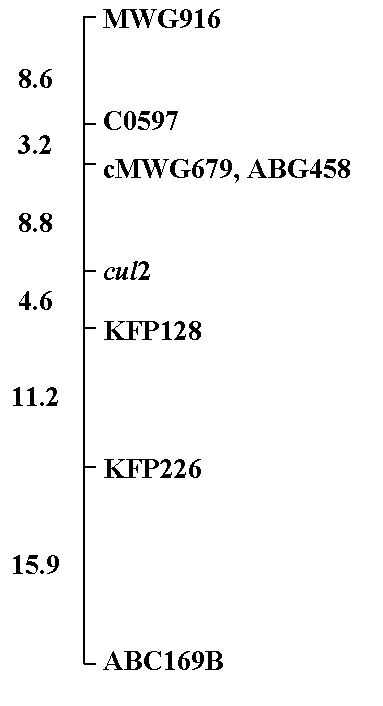
Map Location of the Barley Tillering Mutant uniculm2 (cul2) on Chromosome 6H
Sheri L. Babb and Gary J. Muehlbauer
Department of Agronomy and Plant Genetics, University of Minnesota,
St. Paul, MN 55108

Sheri L. Babb and Gary J. Muehlbauer
Department of Agronomy and Plant Genetics, University of Minnesota,
St. Paul, MN 55108
Plant architecture is an important characteristic in barley and in all agricultural crops. The number and vigor of tillers defines grass architecture and plays a major role in determining final crop yield. Therefore, we are interested in studying the genes involved in tillering in barley by examining a collection of single gene recessive barley tillering mutants. We have focused our research on one of these mutants, uniculm2 (cul2). cul2 is a single gene recessive mutation in barley that does not produce tillers and, in comparison with wild-type tillering plants, grows taller, has wider and longer, leaves, produces a thicker stem, and exhibits a longer spike.
To facilitate future positional cloning of cul2, we placed the cul2 gene on the barley molecular marker map. Previously, cul2 had been placed on chromosome 6H of the barley morphological map (Franckowiak, 1997); therefore, we focused our mapping efforts on chromosome 6H. cul2 plants in a Bowman genetic background (GSHO 2074) were crossed with Bowman and an F2 population was generated that segregated for cul2. Seven RFLP probes from chromosome 6H were found to be polymorphic for the cul2 and Bowman parents. DNA was extracted from 169 individual F2 plants, and using DNA gel-blot analysis, hybridized to the seven polymorphic RFLP probes. Genotypes of the individual 169 plants were identified in the F3. Linkage analysis, performed using Mapmaker, placed cul2 9.5 cM from ABG458 and cMWG679 and 4.8 cM from KFP128 (Figure 1).
Figure 1. Position of cul2 on chromosome 6H. Map distances are expressed in cM.

Reference
Franckowiak, J.D. 1997. Barley Genetics Newsletter. 26:234.